Integrated Landslide Risk Assessment via a Landslide Susceptibility Model Based on Intelligent Optimization Algorithms
Abstract
:1. Introduction
- (1)
- Based on disaster risk theory and intelligent optimization algorithms, the RIME-XGBoost model is innovatively developed, significantly enhancing the accuracy of landslide susceptibility prediction, thus providing a solid data foundation for landslide risk assessment.
- (2)
- A comprehensive landslide risk index is developed, facilitating the evaluation of regional landslide risk. This index identifies areas with varying levels of risk due to spatial heterogeneity in geological, geographical, and socio-economic conditions.
- (3)
- This study investigates the mechanisms through which landslide susceptibility predictions influence landslide risk, offering robust theoretical support for disaster management agencies in formulating more precise and effective disaster prevention and mitigation measures.
2. Study Area and Dataset
2.1. Study Area
2.2. Data Collection and Preprocessing
2.2.1. Landslide Inventory Data
2.2.2. Landslide Susceptibility Assessment Data
2.2.3. Landslide Hazard Assessment Data
2.2.4. Landslide Vulnerability Assessment Data
3. Integrated Landslide Risk Assessment Methods
3.1. Landslide Risk Assessment Model
3.1.1. Hazard
3.1.2. Vulnerability
3.1.3. Risk
3.2. RIME-XGBoost Landslide Susceptibility Assessment Model
3.2.1. XGBoost Model
3.2.2. XGBoost Model Based on RIME Optimization
| Algorithm 1. Pseudocode of the positive greedy selection mechanism |
| Initialize the RIME population Q |
| Obtain the current optimal agent and fitness value |
| While |
| For |
| If |
| If |
| End If |
| End If |
| End For |
| End While |
3.2.3. Model Accuracy Evaluation
4. Results
4.1. Landslide Susceptibility Assessment Results
4.1.1. Landslide Factor Selection
4.1.2. Relationships Between Landslides and Various Influencing Factors
4.1.3. Performance Evaluation of Landslide Susceptibility Models
- (1)
- Optimization of model parameters
- (2)
- Confusion matrix
- (3)
- ROC curve
- (4)
- Uncertainty analysis based on the cloud theory
- (1)
- Expectation refers to the overall expectation within the region, generally described using the sample mean.
- (2)
- Entropy is an indicator used to comprehensively measure the fuzzy degree of qualitative concepts and probabilities, i.e., randomness. In the text, it mainly reflects the fluctuation range of the errors within the model forecasting range.
- (3)
- Super-entropy describes the uncertainty of entropy , and its numerical value indicates the degree of data dispersion. The greater the value, the greater the degree of dispersion. In the text, it mainly reflects the frequency of error fluctuations within the model forecasting range.
4.1.4. Mapping of the Landslide Susceptibility with the Different Models
4.2. Landslide Risk Assessment Results
4.2.1. Analysis of Landslide Hazard Assessment Results
4.2.2. Analysis of Landslide Vulnerability Assessment Result
4.2.3. Analysis of Landslide Risk Assessment Result
4.2.4. Improvement in Landslide Risk Through Enhanced Susceptibility Accuracy: Insights from Multi-Model Comparison
5. Discussion
5.1. Landslide Event Validation
5.2. Improved Landslide Susceptibility Model for Enhanced Spatial Risk Assessment Reliability
5.3. Integrated Landslide Risk Assessment Results to Guide Prevention and Control Strategies
5.4. Prospects for a Comprehensive Risk Evaluation Framework for Landslides from a Multi-Model Perspective
6. Conclusions
- (1)
- The RIME-XGBoost-based landslide susceptibility model shows the smallest expectation and super-entropy, indicating the accuracy and stability of the RIME-XGBoost predictions. Additionally, the XGBoost model optimized by RIME outperforms the standard XGBoost model, with an AUC score of 0.947 and an increase of 0.064. Compared to other models, its accuracy improved by up to 0.15.
- (2)
- Landslide susceptibility results show that landslides are mainly concentrated in high- and very-high-susceptibility zones. While the very-high-susceptibility zone covers only 8% of the area, it includes 82% of the landslides. A high-susceptibility corridor runs southwest–northeast along the Yangtze River, likely due to complex geology and river erosion. A risk assessment indicates that 72% of the region has a very low landslide risk, with 26% having a low to moderate risk. High- and very-high-risk areas, covering just over 1% of the total area, are concentrated in urban centers, where dense populations, economic activity, and infrastructure elevate the risk.
- (3)
- This study examines how landslide susceptibility predictions influence landslide risk modeling. In high-risk areas with dense populations, the RIME-XGBoost model accurately predicted risks to buildings and roads, aligning with actual conditions, while XGBoost and PSO-XGBoost both underestimated the risk. In sparsely populated areas, the risk predictions from all three XGBoost-based models showed minimal differences. Thus, RIME-XGBoost offers a more precise depiction of high-risk zones in populated regions, enhancing the reliability of risk assessment.
Author Contributions
Funding
Data Availability Statement
Acknowledgments
Conflicts of Interest
Appendix A
| Date | Location | Volume (m3) | Description | Source |
|---|---|---|---|---|
| 29 July 2024 | Group 4, Yanzi Village, Xiong Family Town | 1200 | House damage | https://www.cqrb.cn/jingji/zixun/2024-07-30/1981598_pc.html (accessed on 15 August 2024) |
| 17 July 2024 | Group 3, Maidiping, Fuqiang Village, Tiefeng Township | ---- | Cracks formed at the landslide edge, posing safety risks | https://new.qq.com/rain/a/20240722A04ISH00 (accessed on 15 August 2024) |
| 4 July 2023 | Shatan village, Changtan township | ---- | House collapse, three people buried after heavy rainstorm | https://new.qq.com/rain/a/20230706A01WE400 (accessed on 15 January 2024) |
| 30 June 2023 | Banshui town | ---- | Buried a residential house, killing six people | https://new.qq.com/rain/a/20230701A0685O00 (accessed on 15 January 2024) |
| 26 August 2021 | Yujia Town-Kaijiang County Road | ---- | Caused road disruption and river blockage | https://wanzhou.cbg.cn/show/6619-1522911.html (accessed on 15 January 2024) |
| 23 August 2021 | Yunyang-Longju section, Provincial Highway 507 | 2000 | Caused road disruption | |
| 16 July 2020 | Intersection of National Highway 318 and Longli Village | Over 4000 | Temporary interruption of National Highway 318 | https://tv.cctv.com/2020/07/24/VIDEym0XcEPdSXaYK8uztHQJ200724.shtml?spm=C53156045404.P4HrRJ64VBfu.0.0 (accessed on 15 January 2024) |
| 16 July 2020 | Intersection of National Highway 318 and Road to Xiangtan Community Group 3 | Over 20,000 | Road damage | |
| 4 April 2013 | Sunjia township | 1.5 million | Horizontal movement of 30 m; destroyed roads, terraces, and houses | [84,85] |
| Model | Proportion | Landslide Susceptibility Class | ||||
|---|---|---|---|---|---|---|
| Very Low | Low | Moderate | High | Very High | ||
| XGBoost | Landslide proportion (%) | 2.539 | 3.808 | 2.821 | 5.219 | 85.614 |
| Area proportion (%) | 32.691 | 21.162 | 15.394 | 16.759 | 13.993 | |
| PSO-XGBoost | Landslide proportion (%) | 2.962 | 3.385 | 3.808 | 5.078 | 84.767 |
| Area proportion (%) | 35.793 | 20.447 | 16.675 | 15.730 | 11.356 | |
| RIME-XGBoost | Landslide proportion (%) | 2.821 | 3.808 | 6.065 | 4.937 | 82.370 |
| Area proportion (%) | 33.433 | 22.786 | 20.800 | 14.684 | 8.297 | |
| Class | Very Low | Low | Moderate | High | Very High |
|---|---|---|---|---|---|
| Landslide proportion (%) | 2.821 | 4.654 | 7.898 | 7.898 | 76.728 |
| Area proportion (%) | 28.865 | 22.350 | 20.157 | 15.507 | 13.121 |
| Class | Very Low | Low | Moderate | High | Very High |
|---|---|---|---|---|---|
| Area (km2) | 1467.765 | 1583.803 | 241.571 | 69.797 | 38.59 |
| Area proportion (%) | 43.15 | 46.562 | 7.102 | 2.052 | 1.134 |
| Class | Very Low | Low | Moderate | High | Very High |
|---|---|---|---|---|---|
| Area (km2) | 2458.325 | 825.300 | 74.617 | 29.603 | 13.297 |
| Area proportion (%) | 72.279 | 24.265 | 2.194 | 0.870 | 0.391 |
| Model | Spatial Distribution Characteristics of Susceptibility | Spatial Distribution Characteristics of Risk | Analysis of Disaster-Causing Factors | ||
|---|---|---|---|---|---|
| Similarities | Differences | Similarities | Differences | ||
| RIME-XGBoost | The spatial distribution of susceptibility within the region is distinct, with the area in the lower-right corner exhibiting a high level of susceptibility. | Within the region, areas along the main road (generally oriented southwest–northeast) and its surrounding zones exhibit very high susceptibility. | The spatial distribution of risk within the region is distinct, with the area in the lower-right corner exhibiting a high level of risk. | The areas along the main road and the nearby buildings are classified as high-risk. | The region is divided by a southwest–northeast road, creating a distinct highland–lowland terrain. The western side exceeds 560 m in altitude, while the eastern side ranges from 150 to 220 m. The landslide occurs at the junction of these terrains, with an elevation difference of about 30 m. Despite dense vegetation, the mixed sedimentary rock lithology, a highly susceptible type in Wanzhou County, combined with a 20.6° slope, makes the area prone to landslides, especially under extreme rainfall and human influence. |
| PSO-XGBoost | Around the main road segments, approximately half of the area exhibits moderate susceptibility. | Approximately half of the areas along the main road are classified as moderate-risk. The risk in some road and building areas has been underestimated. | |||
| Model | |||||
| Model | Spatial Distribution Characteristics of Susceptibility | Spatial Distribution Characteristics of Risk | Analysis of Disaster-Causing Factors | |
|---|---|---|---|---|
| Similarities | Differences | |||
| RIME-XGBoost | The spatial distribution of susceptibility within the region is distinct, with an overall high level of susceptibility. | The susceptibility on the east side of the road is predominantly high, while the west side is primarily moderate. | All three models show a low overall risk level for the region, despite minimal differences. | The landslide occurred at 357–370 m elevation, with slopes of 14.7–16.5°. The landslide body, adjacent to the road, poses a significant threat. The area’s mixed sedimentary rock lithology further confirms its high landslide susceptibility in Wanzhou County. |
| PSO-XGBoost | The susceptibility on the east side of the road ranges from high to very high, while the west side is primarily moderate to high. | |||
| Model | ||||
| Landslide Name | Time | Landslide Overview and Causes | Field Disaster Images | Comparison of Model Evaluation Results and Actual Conditions Incorporating Disaster-Causing Factors |
|---|---|---|---|---|
| Houcaowan landslide | 16 July 2020 | The landslide, 30 m wide, 20 to 25 m long, and 1.5 m thick, with a volume of 900 m3, impacted National Highway G318. Composed of silty clay, sandstone, and 30% gravel, the debris caused embankment subsidence, suspending the road and creating cracks. Around 500 cubic meters of loose debris remain, threatening the highway, 50 m below. Heavy rainfall directly triggered the landslide. |  | The landslide area, with mixed sedimentary rocks and an 18.13° slope, is near a road and 340 m from the nearest water system. River erosion and road construction have weakened slope stability, increasing landslide risk. Extreme rainfall heightens the likelihood of landslides. The area, with nearby roads and buildings, poses a significant infrastructure threat. The risk assessment confirms a high risk level, consistent with field conditions. |
| Xinju landslide | 18 July 2020 | The landslide was located behind the new houses of Longbao Village, with a width of approximately 30 m, a length of about 15 m, an average thickness of 15 m, and a volume of approximately 500 cubic meters. The landslide’s mass was primarily composed of silty clay, with about 10% gravel content. After deformation, the landslide locally collapsed by approximately 10 m, directly impacting the new houses at the base of the steep slope. Heavy rainfall was the direct trigger of the landslide. | 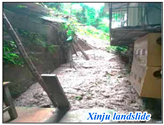 | The landslide area is approximately 134 m from the road and about 424 m from the nearest water system. It occurred on a slope of 17.9°. Google satellite imagery shows that the surrounding area consists of extensive agricultural land and buildings, all of which are under significant threat. The risk assessment results indicate that the landslide is located in a high-risk area, consistent with the actual field conditions. |
| Dazhuanglin landslide | 16 July 2020 | The landslide occurred in Group 1 of Zhaomu Village, Cizhu Township. It was substantial, measuring approximately 20 m in width and 15 m in length, with an average thickness of 3 m and an estimated volume of 900 cubic meters. The landslide consisted of gray-yellow sandstone gravel, cohesive soil, and sand. Data confirmed that heavy rainfall was the direct trigger. Fortunately, there were no casualties or property damage. | 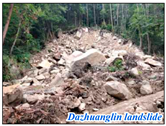 | With 1862 mm of annual rainfall and an elevation of 810 m, the region is more prone to landslides. The event occurred on a 21.87° slope, near the main fault and 2 km from the water system. While classified as high susceptibility, the remote location, limited access, and few nearby buildings reduce the risk to the people, economy, and infrastructure. |
References
- Wang, X.; Wang, Y.; Lin, Q.; Yang, X. Assessing Global Landslide Casualty Risk Under Moderate Climate Change Based on Multiple GCM Projections. Int. J. Disaster Risk Sci. 2023, 14, 751–767. [Google Scholar] [CrossRef]
- Sim, K.B.; Lee, M.L.; Wong, S.Y. A review of landslide acceptable risk and tolerable risk. Geoenviron. Disasters 2022, 9, 3. [Google Scholar] [CrossRef]
- Fidan, S.; Tanyaş, H.; Akbaş, A.; Lombardo, L.; Petley, D.N.; Görüm, T. Understanding fatal landslides at global scales: A summary of topographic, climatic, and anthropogenic perspectives. Nat. Hazards 2024, 120, 6437–6455. [Google Scholar] [CrossRef]
- Dai, F.C.; Lee, C.F.; Ngai, Y.Y. Landslide risk assessment and management: An overview. Eng. Geol. 2002, 64, 65–87. [Google Scholar] [CrossRef]
- Huang, Y.; Zhao, L. Review on landslide susceptibility mapping using support vector machines. Catena 2018, 165, 520–529. [Google Scholar] [CrossRef]
- Tian, N.; Lan, H. The indispensable role of resilience in rational landslide risk management for social sustainability. Geogr. Sustain. 2023, 4, 70–83. [Google Scholar] [CrossRef]
- Flentje, P.; Chowdhury, R. Resilience and sustainability in the management of landslides. Proc. Inst. Civ. Eng.-Eng. Sustain. 2018, 171, 3–14. [Google Scholar] [CrossRef]
- Perera, E.N.C.; Jayawardana, D.T.; Jayasinghe, P.; Bandara, R.M.S.; Alahakoon, N. Direct impacts of landslides on socio-economic systems: A case study from Aranayake, Sri Lanka. Geoenviron. Disasters 2018, 5, 11. [Google Scholar] [CrossRef]
- Lacroix, P.; Handwerger, A.L.; Bièvre, G. Life and death of slow-moving landslides. Nat. Rev. Earth Environ. 2020, 1, 404–419. [Google Scholar] [CrossRef]
- IFRC. 2020 Global Natural Disaster Assessment Report; IFRC: Geneva, Switzerland, 2021. [Google Scholar]
- UNOCHA. Asia and the Pacific: Weekly Regional Humanitarian Snapshot (6–13 August 2019); UNOCHA: New York, NY, USA, 2019. [Google Scholar]
- Froude, M.J.; Petley, D.N. Global fatal landslide occurrence from 2004 to 2016. Nat. Hazards Earth Syst. Sci. 2018, 18, 2161–2181. [Google Scholar] [CrossRef]
- Chen, W.; Xie, X.; Wang, J.; Pradhan, B.; Hong, H.; Bui, D.T.; Duan, Z.; Ma, J. A comparative study of logistic model tree, random forest, and classification and regression tree models for spatial prediction of landslide susceptibility. Catena 2017, 151, 147–160. [Google Scholar] [CrossRef]
- Jemec Auflič, M.; Bezak, N.; Šegina, E.; Frantar, P.; Gariano, S.L.; Medved, A.; Peternel, T. Climate change increases the number of landslides at the juncture of the Alpine, Pannonian and Mediterranean regions. Sci. Rep. 2023, 13, 23085. [Google Scholar] [CrossRef] [PubMed]
- Liu, J.; Wu, Y.; Gao, X. Increase in occurrence of large glacier-related landslides in the high mountains of Asia. Sci. Rep. 2021, 11, 1635. [Google Scholar] [CrossRef] [PubMed]
- Alcántara-Ayala, I.; Sassa, K. Landslide risk management: From hazard to disaster risk reduction. Landslides 2023, 20, 2031–2037. [Google Scholar] [CrossRef]
- Yong, C.; Dong, J.; Fei, G.; Bin, T.; Tao, Z.; Hao, F.; Li, W.; Qinghua, Z. Review of landslide susceptibility assessment based on knowledge mapping. Stoch. Environ. Res. Risk Assess. 2022, 36, 2399–2417. [Google Scholar] [CrossRef]
- Sezer, E.A.; Nefeslioglu, H.A.; Osna, T. An expert-based landslide susceptibility mapping (LSM) module developed for Netcad Architect Software. Comput. Geosci. 2017, 98, 26–37. [Google Scholar] [CrossRef]
- Lyu, H.-M.; Shen, J.S.; Arulrajah, A. Assessment of Geohazards and Preventative Countermeasures Using AHP Incorporated with GIS in Lanzhou, China. Sustainability 2018, 10, 304. [Google Scholar] [CrossRef]
- Shahabi, H.; Hashim, M.; Ahmad, B.B. Remote sensing and GIS-based landslide susceptibility mapping using frequency ratio, logistic regression, and fuzzy logic methods at the central Zab basin, Iran. Environ. Earth Sci. 2015, 73, 8647–8668. [Google Scholar] [CrossRef]
- Hu, Q.; Zhou, Y.; Wang, S.; Wang, F. Machine learning and fractal theory models for landslide susceptibility mapping: Case study from the Jinsha River Basin. Geomorphology 2020, 351, 106975. [Google Scholar] [CrossRef]
- Xiong, J.; Zhu, J.; Su, P.; Gong, Y.; Zhao, Y.; Li, J.; Li, W. Risk Assessment of Landslide in the Xiluodu Reservoir Area Based on GIS and Information Value Method. Resour. Environ. Yangtze Basin 2019, 28, 700–711. [Google Scholar]
- Zhang, Y.-X.; Lan, H.-X.; Li, L.-P.; Wu, Y.-M.; Chen, J.-H.; Tian, N.-M. Optimizing the frequency ratio method for landslide susceptibility assessment: A case study of the Caiyuan Basin in the southeast mountainous area of China. J. Mt. Sci. 2020, 17, 340–357. [Google Scholar] [CrossRef]
- Liu, L.; Gao, H. Landslide susceptibility assessment using the coupling of WOE and logistic regression models. J. Eng. Geol. 2023, 31, 165–175. [Google Scholar]
- Zhang, Z.; Deng, M.; Xu, S.; Zhang, Y.; Fu, H.; Li, Z. Comparison of landslide susceptibility assessment models in Zhenkang County, Yunnan Province, China. Chin. J. Rock Mech. Eng. 2022, 41, 157–171. [Google Scholar]
- Wu, R.; Hu, X.; Mei, H.; He, J.; Yang, J. Spatial susceptibility assessment of landslides based on random forest: A case study from Hubei section in the Three Gorges Reservoir area. Earth Sci. 2021, 46, 321–330. [Google Scholar]
- Liu, J.; Liang, E.; Xu, S.; Liu, M.; Wang, Y.; Zhang, F.; Luo, A. Multi-kernel support vector machine considering sample optimization selection for analysis and evaluation of landslide disaster susceptibility. Acta Geod. Cartogr. Sin. 2022, 51, 2034–2045. [Google Scholar]
- Huang, W.; Ding, M.; Wang, D.; Jiang, L.; Li, Z. Evaluation of landslide susceptibility based on layer adaptive weighted convolutional neural network model along Sichuan-Tibet traffic corridor. Earth Sci. 2022, 47, 2015–2030. [Google Scholar]
- Huang, F.; Cao, Z.; Guo, J.; Jiang, S.-H.; Li, S.; Guo, Z. Comparisons of heuristic, general statistical and machine learning models for landslide susceptibility prediction and mapping. Catena 2020, 191, 104580. [Google Scholar] [CrossRef]
- Jiang, Z.; Wang, M.; Liu, K. Comparisons of Convolutional Neural Network and Other Machine Learning Methods in Landslide Susceptibility Assessment: A Case Study in Pingwu. Remote Sens. 2023, 15, 798. [Google Scholar] [CrossRef]
- Huang, W.; Ding, M.; Li, Z.; Yu, J.; Ge, D.; Liu, Q.; Yang, J. Landslide susceptibility mapping and dynamic response along the Sichuan-Tibet transportation corridor using deep learning algorithms. Catena 2023, 222, 106866. [Google Scholar] [CrossRef]
- Janizadeh, S.; Bateni, S.M.; Jun, C.; Pal, S.C.; Band, S.S.; Chowdhuri, I.; Saha, A.; Tiefenbacher, J.P.; Mosavi, A. Potential impacts of future climate on the spatio-temporal variability of landslide susceptibility in Iran using machine learning algorithms and CMIP6 climate-change scenarios. Gondwana Res. 2023, 124, 1–17. [Google Scholar] [CrossRef]
- Shua, Q.; Peng, H.; Li, J. Landslide susceptibility prediction modelling based on semi-supervised XGBoost model. Geol. J. 2024, 59, 2655–2667. [Google Scholar] [CrossRef]
- Zhang, W.; He, Y.; Wang, L.; Liu, S.; Meng, X. Landslide susceptibility mapping using random forest and extreme gradient boosting: A case study of Fengjie, Chongqing. Geol. J. 2023, 58, 2372–2387. [Google Scholar] [CrossRef]
- Balogun, A.-L.; Rezaie, F.; Quoc Bao, P.; Gigovic, L.; Drobnjak, S.; Aina, Y.A.; Panahi, M.; Yekeen, S.T.; Lee, S. Spatial prediction of landslide susceptibility in western Serbia using hybrid support vector regression (SVR) with GWO, BAT and COA algorithms. Geosci. Front. 2021, 12, 101104. [Google Scholar] [CrossRef]
- Reichenbach, P.; Rossi, M.; Malamud, B.D.; Mihir, M.; Guzzetti, F. A review of statistically-based landslide susceptibility models. Earth Sci. Rev. 2018, 180, 60–91. [Google Scholar] [CrossRef]
- Wang, Q.; Xiong, J.; Cheng, W.; Cui, X.; Pang, Q.; Liu, J.; Chen, W.; Tang, H.; Song, N. Landslide susceptibility mapping methods coupling with statistical methods, machine learning models and clustering algorithms. J. Geo-Inf. Sci. 2024, 26, 620–637. [Google Scholar]
- Sun, D.; Xu, J.; Wen, H.; Wang, D. Assessment of landslide susceptibility mapping based on Bayesian hyperparameter optimization: A comparison between logistic regression and random forest. Eng. Geol. 2021, 281, 105972. [Google Scholar] [CrossRef]
- Le Thi, L.; Hoang, N.; Zhou, J.; Dou, J.; Moayedi, H. Estimating the heating load of buildings for smart city planning using a novel artificial intelligence technique PSO-XGBoost. Appl. Sci. 2019, 9, 2714. [Google Scholar] [CrossRef]
- Ding, C.; Wang, X.; Chen, T.; Yu, T. Application of Bayesian optimized XGBoost in seismic interpretation of small-scale faults. J. China Coal Soc. 2023, 48, 2530–2539. [Google Scholar]
- Su, H.; Zhao, D.; Heidari, A.A.; Liu, L.; Zhang, X.; Mafarja, M.; Chen, H. RIME: A physics-based optimization. Neurocomputing 2023, 532, 183–214. [Google Scholar] [CrossRef]
- Sultana, N.; Tan, S.; Hossen, M.F. Landslide risk assessment by integrating hazards and vulnerability indices in Southeast Bangladesh. Int. J. Disaster Risk Reduct. 2024, 114, 104991. [Google Scholar] [CrossRef]
- Chang, M.; Dou, X.; Zhu, X.; Ma, Y. Integrated risk assessment of landslide in karst terrains: Advancing landslides management in Beiliu City, China. Int. J. Appl. Earth Obs. Geoinf. 2024, 132, 104046. [Google Scholar] [CrossRef]
- Liu, X.; Miao, C. Large-scale assessment of landslide hazard, vulnerability and risk in China. Geomat. Nat. Hazards Risk. 2018, 9, 1037–1052. [Google Scholar] [CrossRef]
- Ferrer, J.; Guo, Z.; Medina, V.; Puig-Polo, C.; Hurlimann, M. A framework to project future rainfall scenarios: An application to shallow landslide-triggering summer rainfall in Wanzhou County, China. Water 2022, 14, 873. [Google Scholar] [CrossRef]
- Zhang, S.; Bai, L.; Li, Y.; Li, W.-L.; Xie, M. Comparing Convolutional Neural Network and Machine Learning Models in Landslide Susceptibility Mapping: A Case Study in Wenchuan County. Front. Environ. Sci. 2022, 10, 886841. [Google Scholar] [CrossRef]
- Xu, Y.; Ouyang, C.; Xu, Q.; Wang, D.; Zhao, B.; Luo, Y. CAS Landslide Dataset: A Large-Scale and Multisensor Dataset for Deep Learning-Based Landslide Detection. Sci. Data 2024, 11, 12. [Google Scholar] [CrossRef]
- Pokharel, B.; Alvioli, M.; Lim, S. Assessment of earthquake-induced landslide inventories and susceptibility maps using slope unit-based logistic regression and geospatial statistics. Sci. Rep. 2021, 11, 21333. [Google Scholar] [CrossRef]
- Bhuyan, K.; Tanyaş, H.; Nava, L.; Puliero, S.; Meena, S.R.; Floris, M.; van Westen, C.; Catani, F. Generating multi-temporal landslide inventories through a general deep transfer learning strategy using HR EO data. Sci. Rep. 2023, 13, 162. [Google Scholar] [CrossRef]
- Zhao, Z.; Xu, Z.; Hu, C.; Wang, K.; Ding, X. Geographically weighted neural network considering spatial heterogeneity for landslide susceptibility mapping: A case study of Yichang City, China. Catena 2024, 234, 107590. [Google Scholar] [CrossRef]
- Zhang, J.; Ma, X.; Zhang, J.; Sun, D.; Zhou, X.; Mi, C.; Wen, H. Insights into geospatial heterogeneity of landslide susceptibility based on the SHAP-XGBoost model. J. Environ. Manag. 2023, 332, 117357. [Google Scholar] [CrossRef]
- Lee, S. Current and future status of GIS-based landslide susceptibility mapping: A literature review. Korean J. Remote Sens. 2019, 35, 179–193. [Google Scholar] [CrossRef]
- Rabby, Y.W.; Ishtiaque, A.; Rahman, M.S. Evaluating the effects of digital elevation models in landslide susceptibility mapping in Rangamati District, Bangladesh. Remote Sens. 2020, 12, 2718. [Google Scholar] [CrossRef]
- Yu, L.; Wang, Y.; Pradhan, B. Enhancing landslide susceptibility mapping incorporating landslide typology via stacking ensemble machine learning in Three Gorges Reservoir, China. Geosci. Front. 2024, 15, 101802. [Google Scholar] [CrossRef]
- Zhang, Z.; Sun, J. Regional Landslide Susceptibility Assessment and Model Adaptability Research. Remote Sens. 2024, 16, 2305. [Google Scholar] [CrossRef]
- Shahabi, H.; Ahmadi, R.; Alizadeh, M.; Hashim, M.; Al-Ansari, N.; Shirzadi, A.; Wolf, I.D.; Ariffin, E.H. Landslide susceptibility mapping in a mountainous area using machine learning algorithms. Remote Sens. 2023, 15, 3112. [Google Scholar] [CrossRef]
- Ma, S.; Shao, X.; Xu, C. Potential Controlling Factors and Landslide Susceptibility Features of the 2022 Ms 6.8 Luding Earthquake. Remote Sens. 2024, 16, 2861. [Google Scholar] [CrossRef]
- Li, P.; Wang, H.; Li, H.; Ni, Z.; Deng, H.; Sui, H.; Xu, G. Refined Landslide Susceptibility Mapping Considering Land Use Changes and InSAR Deformation: A Case Study of Yulin City, Guangxi. Remote Sens. 2024, 16, 3016. [Google Scholar] [CrossRef]
- Yang, J.; Huang, X. The 30 m annual land cover dataset and its dynamics in China from 1990 to 2019. Earth Syst. Sci. Data 2021, 13, 3907–3925. [Google Scholar] [CrossRef]
- Date, O.P. World: Internationally Agreed Glossary of Basic Terms Related to Disaster Management; UN Department of Humanitarian Affairs: New York, NY, USA, 1992. [Google Scholar]
- Monsieurs, E.; Jacobs, L.; Michellier, C.; Basimike Tchangaboba, J.; Ganza, G.B.; Kervyn, F.; Maki Mateso, J.-C.; Mugaruka Bibentyo, T.; Kalikone Buzera, C.; Nahimana, L.; et al. Landslide inventory for hazard assessment in a data-poor context: A regional-scale approach in a tropical African environment. Landslides 2018, 15, 2195–2209. [Google Scholar] [CrossRef]
- Huang, F.; Mao, D.; Jiang, S.-H.; Zhou, C.; Fan, X.; Zeng, Z.; Catani, F.; Yu, C.; Chang, Z.; Huang, J.; et al. Uncertainties in landslide susceptibility prediction modeling: A review on the incompleteness of landslide inventory and its influence rules. Geosci. Front. 2024, 15, 101886. [Google Scholar] [CrossRef]
- Chang, M.; Cui, P.; Dou, X.; Su, F. Quantitative risk assessment of landslides over the China-Pakistan economic corridor. Int. J. Disaster Risk Reduct. 2021, 63, 102441. [Google Scholar] [CrossRef]
- Chang, M.; Dou, X.; Su, F.; Yu, B. Remote sensing and optimized neural networks for landslide risk assessment: Paving the way for mitigating Afghanistan landslide damage. Ecol. Indic. 2023, 156, 111179. [Google Scholar] [CrossRef]
- Shah, N.A.; Shafique, M.; Ishfaq, M.; Faisal, K.; Van der Meijde, M. Integrated approach for landslide risk assessment using geoinformation tools and field data in Hindukush mountain ranges, Northern Pakistan. Sustainability 2023, 15, 3102. [Google Scholar] [CrossRef]
- Chang, M.; Dou, X.; Tang, L.; Xu, H. Risk assessment of multi-disaster in Mining Area of Guizhou, China. Int. J. Disaster Risk Reduct. 2022, 78, 103128. [Google Scholar] [CrossRef]
- Xiao, T.; Yin, K.; Yao, T.; Liu, S. Spatial prediction of landslide susceptibility using GIS-based statistical and machine learning models in Wanzhou County, Three Gorges Reservoir, China. Acta Geochim. 2019, 38, 654–669. [Google Scholar] [CrossRef]
- Peng, S.; Ding, Y.; Liu, W.; Li, Z. 1 km monthly temperature and precipitation dataset for China from 1901 to 2017. Earth Syst. Sci. Data 2019, 11, 1931–1946. [Google Scholar] [CrossRef]
- Yue, T.; Yin, S.; Xie, Y.; Yu, B.; Liu, B. Rainfall erosivity mapping over mainland China based on high-density hourly rainfall records. Earth Syst. Sci. Data 2022, 14, 665–682. [Google Scholar] [CrossRef]
- United Nations Office for Disaster Risk Reduction (UNDRR). Report of the 2022 Global Platform for Disaster Risk Reduction. Available online: https://globalplatform.undrr.org/syndication/gp2022 (accessed on 21 October 2024).
- Yao, Y.; Cheng, L.; Chen, S.; Chen, H.; Chen, M.; Li, N.; Li, Z.; Dongye, S.; Gu, Y.; Yi, J. Study on Road Network Vulnerability Considering the Risk of Landslide Geological Disasters in China’s Tibet. Remote Sens. 2023, 15, 4221. [Google Scholar] [CrossRef]
- Lei, Y.; Gu, H.; Cui, P. Vulnerability assessment for buildings exposed to torrential hazards at Sichuan-Tibet transportation corridor. Eng. Geol. 2022, 308, 106803. [Google Scholar] [CrossRef]
- Luo, H.Y.; Zhang, L.M.; Zhang, L.L.; He, J.; Yin, K.S. Vulnerability of buildings to landslides: The state of the art and future needs. Earth Sci. Rev. 2023, 238, 104329. [Google Scholar] [CrossRef]
- Li, Z.; He, W.; Cheng, M.; Hu, J.; Yang, G.; Zhang, H. SinoLC-1: The first 1 m resolution national-scale land-cover map of China created with a deep learning framework and open-access data. Earth Syst. Sci. Data 2023, 15, 4749–4780. [Google Scholar] [CrossRef]
- Hengl, T. Global Landform and Lithology Class at 250 m Based on the USGS Global Ecosystem Map (1.0); Zenodo, 2018; Available online: https://zenodo.org/records/1464846 (accessed on 21 October 2024).
- Chen, T.; Guestrin, C. XGBoost: A Scalable Tree Boosting System. In Proceedings of the 22nd ACM SIGKDD International Conference on Knowledge Discovery and Data Mining, San Francisco, CA, USA, 13–17 August 2016; pp. 785–794. [Google Scholar]
- Fawcett, T. An introduction to ROC analysis. Pattern Recognit. Lett. 2006, 27, 861–874. [Google Scholar] [CrossRef]
- Zhang, T.; Huang, Y.; Liao, H.; Gong, X.; Peng, B. Short-term power forecasting and uncertainty analysis of wind farm at multiple time scales. IEEE Access. 2024, 12, 25129–25145. [Google Scholar] [CrossRef]
- Zhang, T.; Huang, Y.; Liao, H.; Liang, Y. A hybrid electric vehicle load classification and forecasting approach based on GBDT algorithm and temporal convolutional network. Appl. Energy 2023, 351, 121768. [Google Scholar] [CrossRef]
- Gu, B.; Zhang, T.; Meng, H.; Zhang, J. Short-term forecasting and uncertainty analysis of wind power based on long short-term memory, cloud model and non-parametric kernel density estimation. Renew. Energy 2021, 164, 687–708. [Google Scholar] [CrossRef]
- Chen, W.; Shahabi, H.; Zhang, S.; Khosravi, K.; Shirzadi, A.; Chapi, K.; Binh Thai, P.; Zhang, T.; Zhang, L.; Chai, H.; et al. Landslide susceptibility modeling based on GIS and novel bagging-based kernel logistic regression. Appl. Sci. 2018, 8, 2540. [Google Scholar] [CrossRef]
- Zhou, C.; Yin, K.; Cao, Y.; Ahmed, B.; Li, Y.; Catani, F.; Pourghasemi, H.R. Landslide susceptibility modeling applying machine learning methods: A case study from Longju in the Three Gorges Reservoir area, China. Comput. Geosci. 2018, 112, 23–37. [Google Scholar] [CrossRef]
- Liang, X. Research on Meteorological Early-Warning for Landslide Risk in Wanzhou District, ThreeGorges Reservoir. Ph.D. Thesis, China Universityof Geosciences (Wuhan), Wuhan, China, 2023. [Google Scholar]
- Xiao, L.; Wang, J.; Zhu, Y.; Zhang, J. Quantitative risk analysis of a rainfall-induced complex landslide in Wanzhou County, Three Gorges Reservoir, China. Int. J. Disaster Risk Sci. 2020, 11, 347–363. [Google Scholar] [CrossRef]
- Wang, J.; Xiao, L.; Zhang, J.; Zhu, Y. Deformation characteristics and failure mechanisms of a rainfall-induced complex landslide in Wanzhou County, Three Gorges Reservoir, China. Landslides 2020, 17, 419–431. [Google Scholar] [CrossRef]
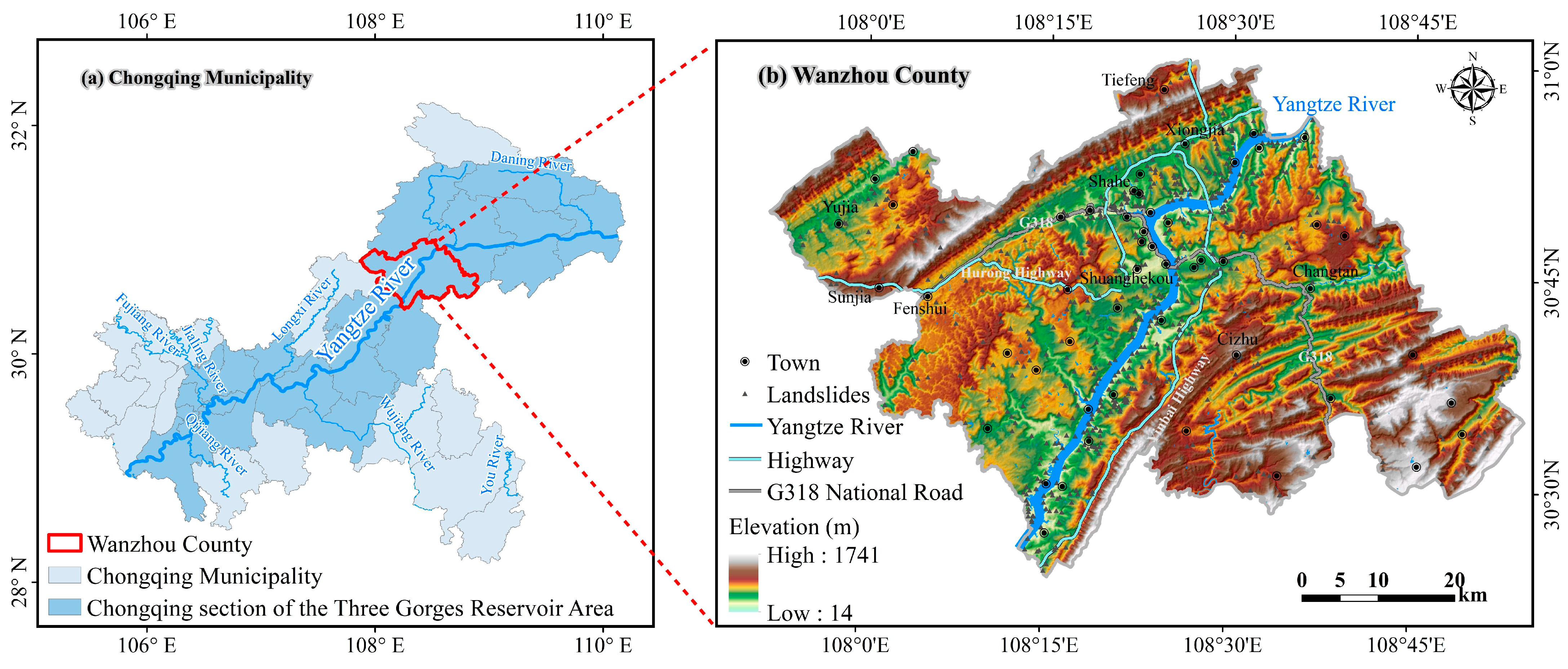

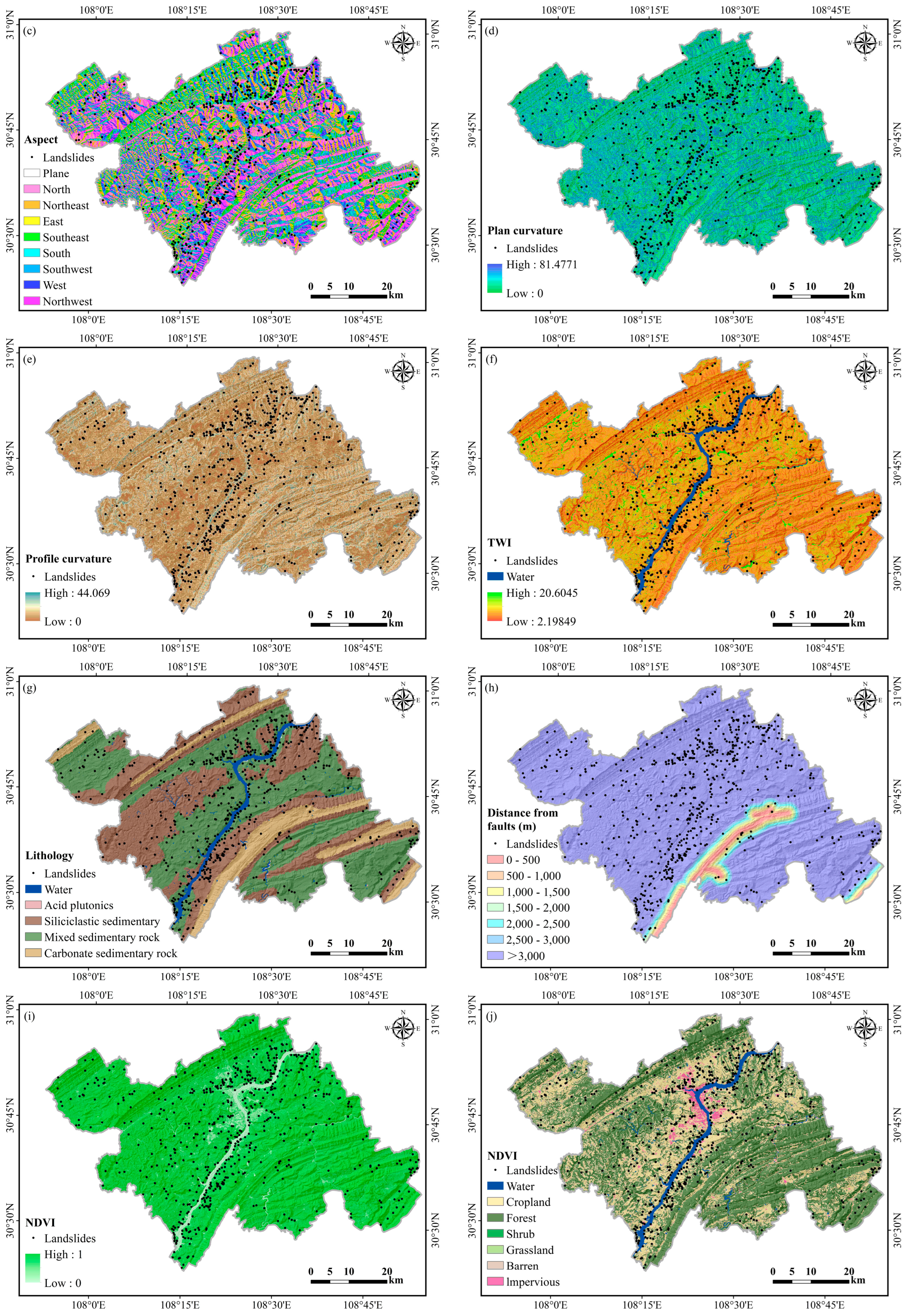
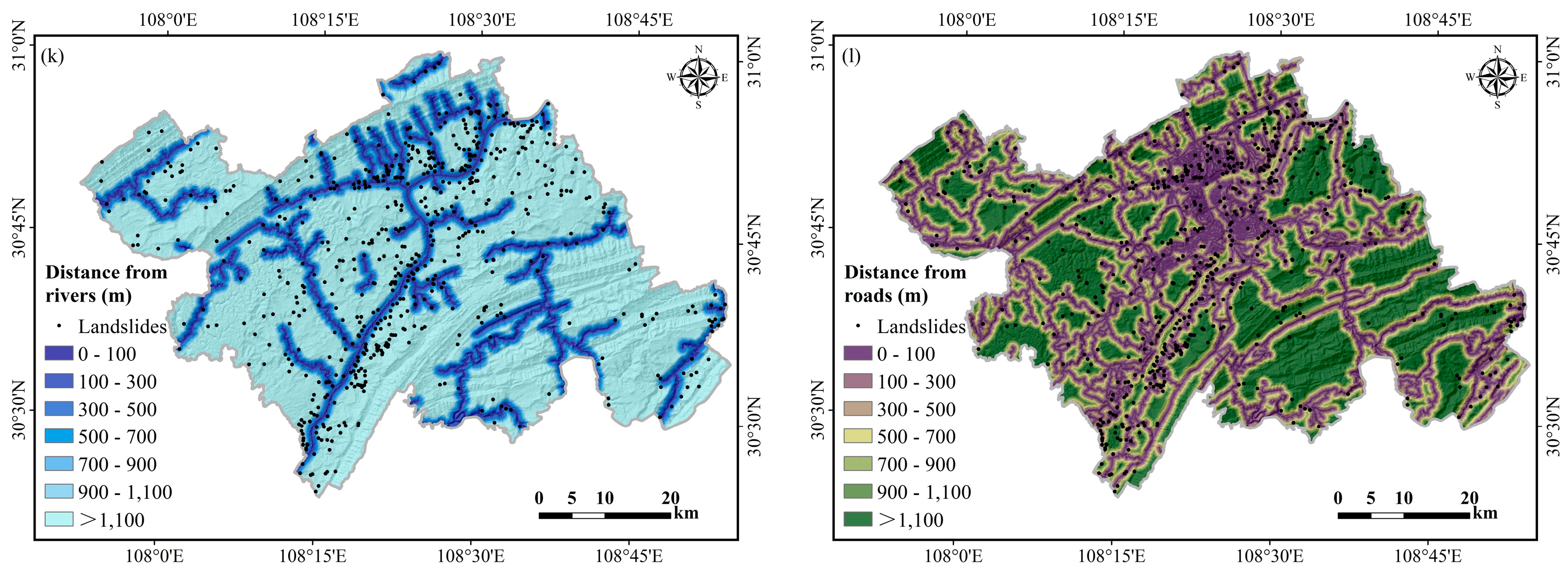

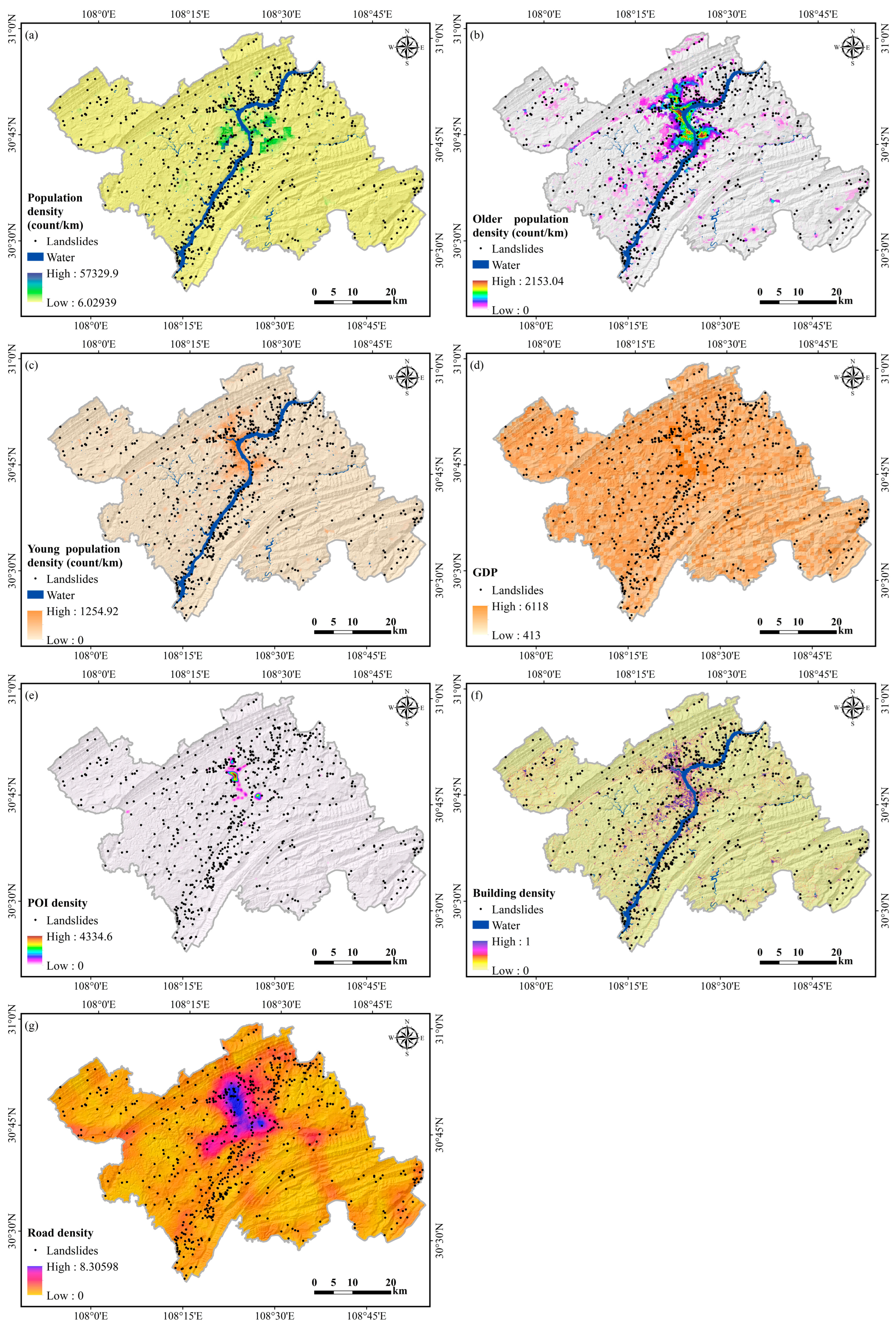
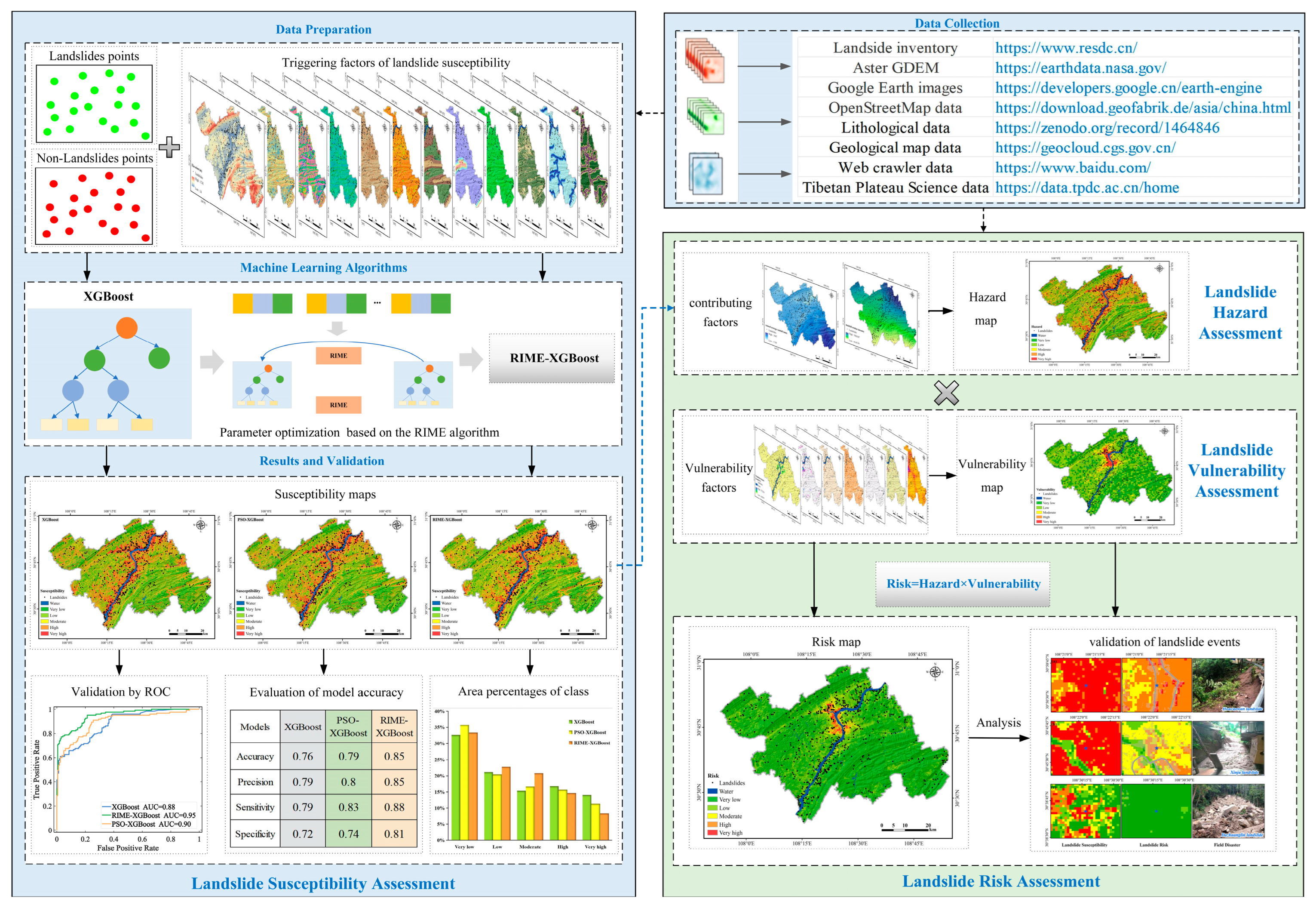
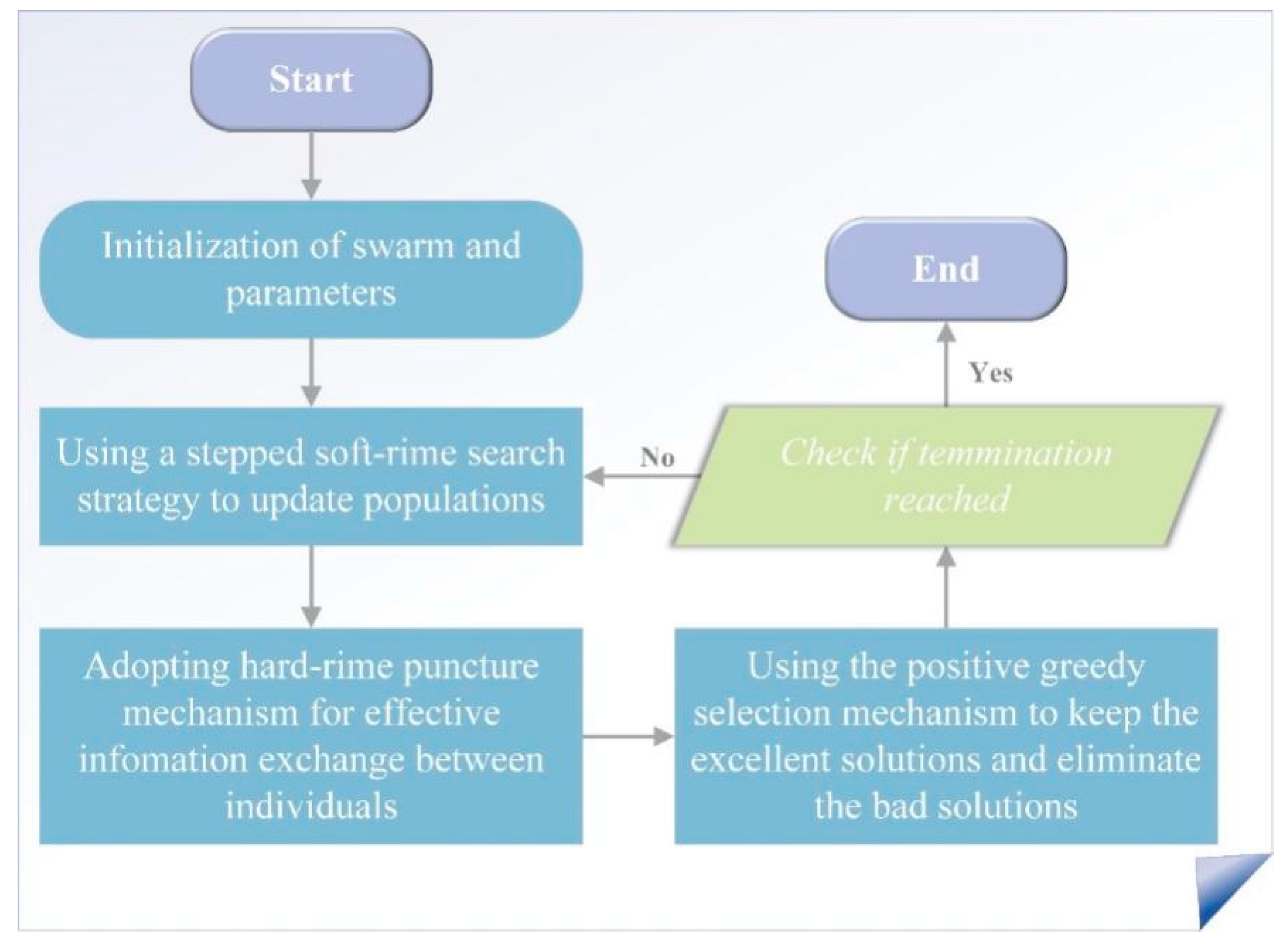

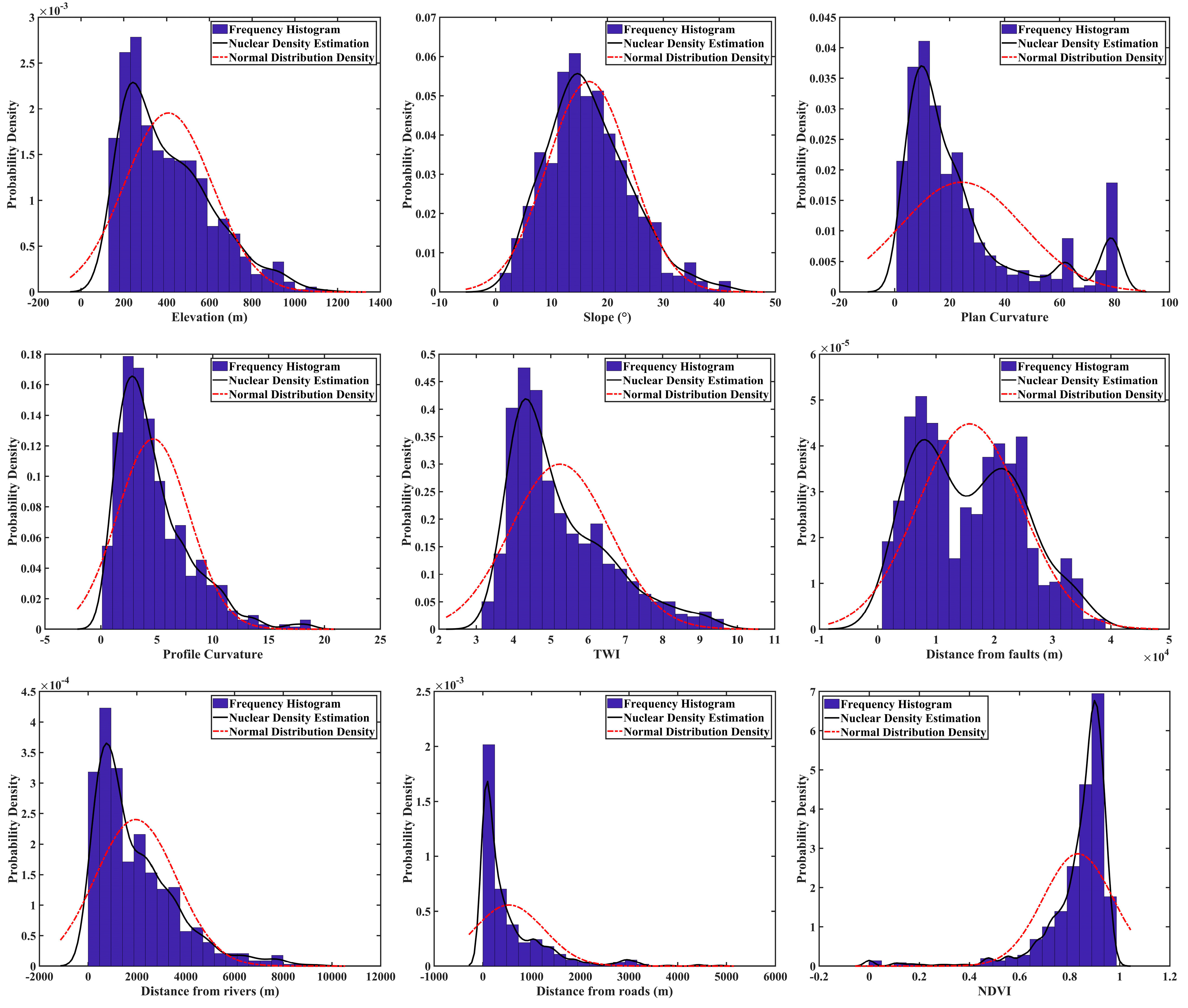

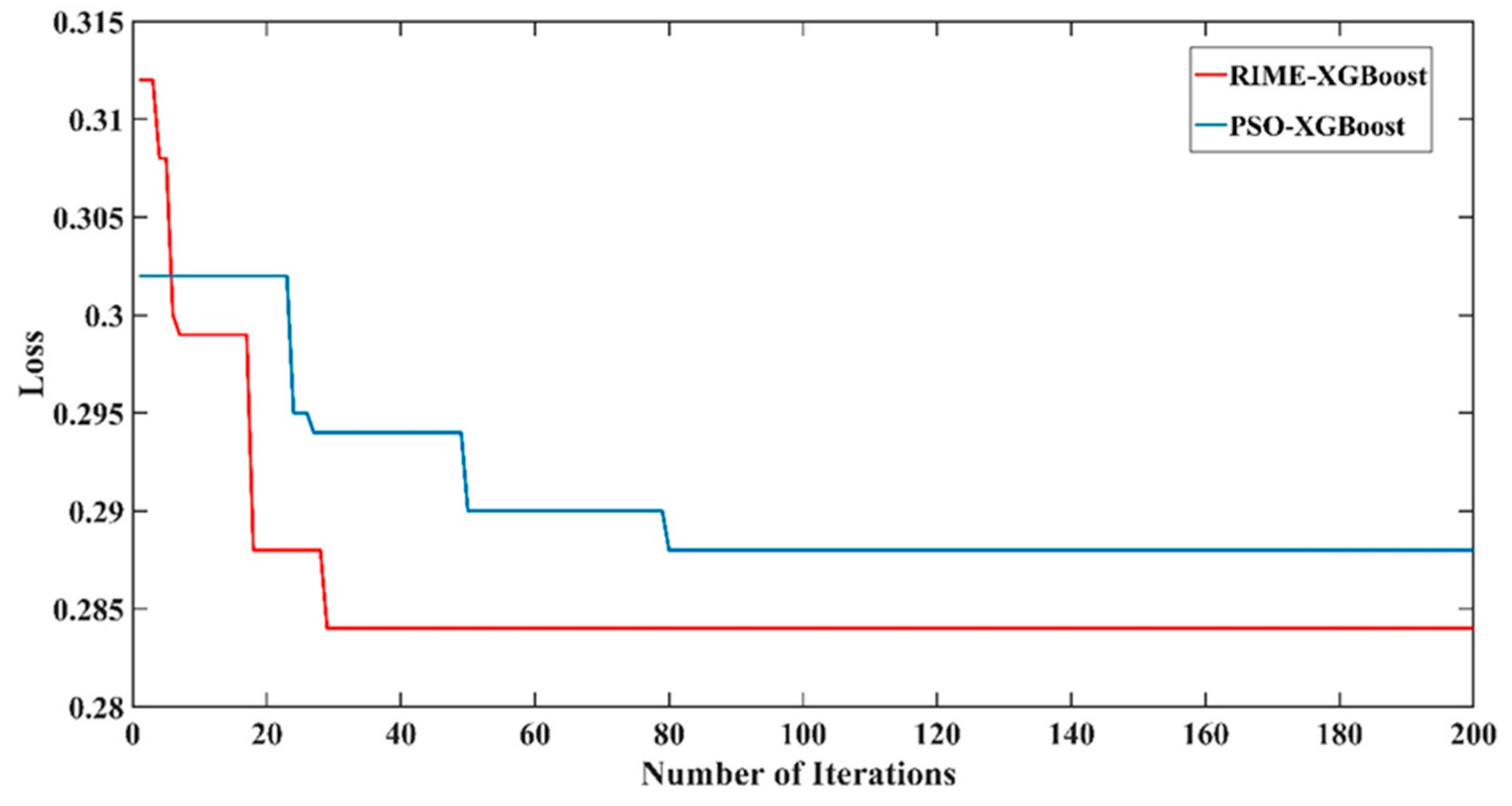



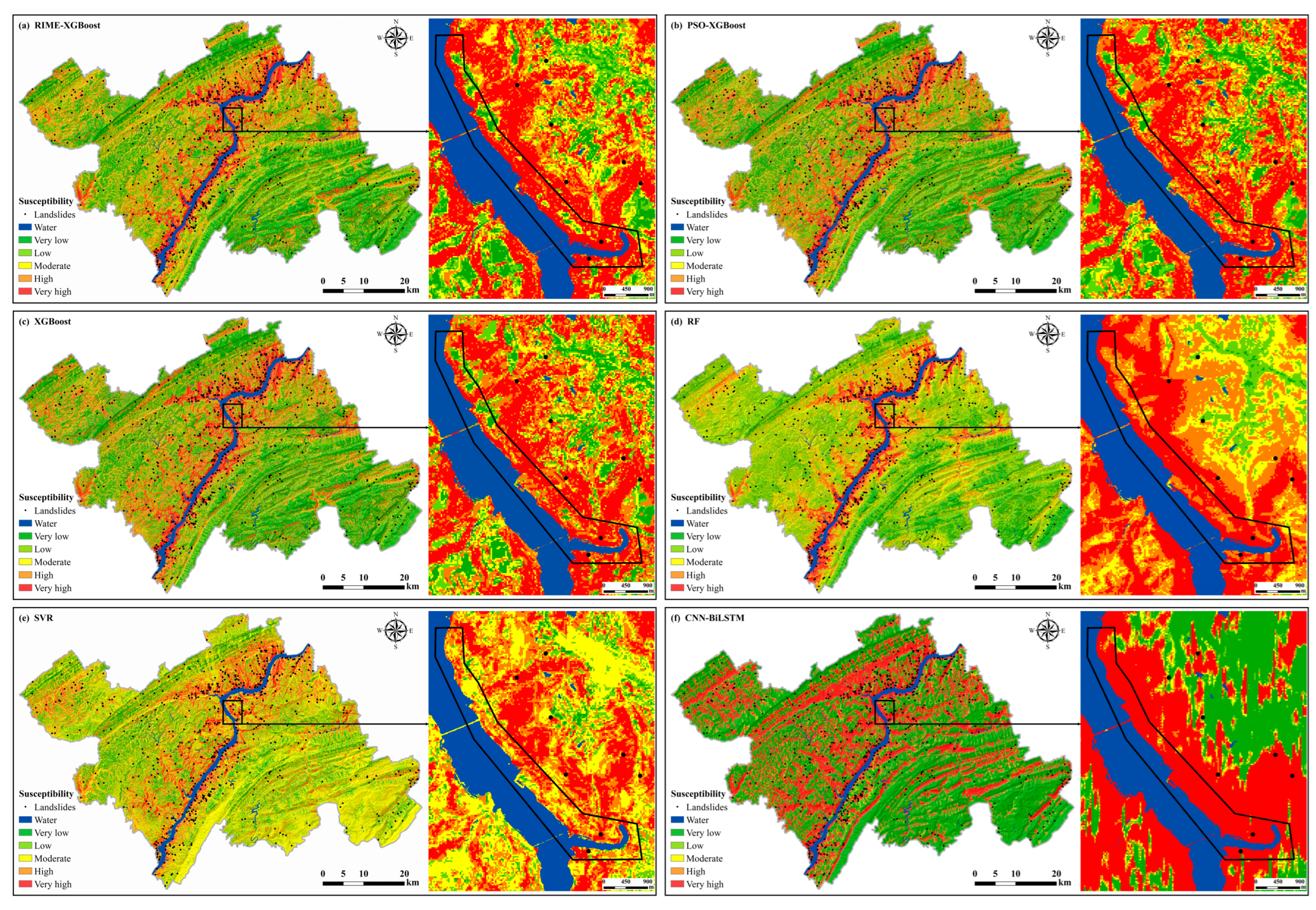





| Factor | Data Type | Data Source | Resolution/Scale |
|---|---|---|---|
| Elevation | Raster | National Aeronautics and Space Administration (https://earthdata.nasa.gov/) (accessed on 1 May 2024) | 30 m |
| Slope | |||
| Aspect | |||
| Plan curvature | |||
| Profile curvature | |||
| TWI | |||
| Lithology | Raster | A new database of global lithological maps [75] (https://zenodo.org/record/1464846) (accessed on 1 May 2024) | 250 m |
| Distance from faults | Vector | National 1:200,000 geological map spatial database (https://geocloud.cgs.gov.cn/) (accessed on 1 May 2024) | 1:200,000 |
| NDVI | Raster | Google Earth Engine (https://developers.google.cn/earth-engine) (accessed on 20 May 2024) | 30 m |
| Land use | Raster | The 30 m annual land-cover datasets [59] (https://zenodo.org/records/8176941) (accessed on 1 May 2024) | 30 m |
| Distance from rivers | Vector | OpenStreetMap (https://download.geofabrik.de/asia/china.html) (accessed on 1 May 2024) | —— |
| Distance from roads | |||
| Building density | Raster | The first 1 m resolution national-scale land-cover map of China [74] (https://zenodo.org/records/8214467) (accessed on 20 May 2024) | 1 m |
| Annual average rainfall | Raster | National Tibetan Plateau Science Data Centre (https://data.tpdc.ac.cn/home) (accessed on 20 May 2024) | 1 km |
| Rainfall erosivity intensity | Raster | https://dx.doi.org/10.12275/bnu.clicia.rainfallerosivity.CN.001 [69] (accessed on 20 May 2024) | 1 km |
| POI | Vector | Web crawler | —— |
| Population | Raster | WorldPop | 100 m |
| GDP | Raster | Resource and Environmental Sciences Data Centre (https://www.resdc.cn/) (accessed on 20 May 2024) | 1 km |
| Road density | Vector | OpenStreetMap (https://download.geofabrik.de/asia/china.html) (accessed on 1 May 2024) | —— |
| Building density | Raster | The first 1 m resolution national-scale land-cover map of China [74] (https://zenodo.org/records/8214467) (accessed on 20 May 2024) | 1 m |
| Number | Factor | Collinearity Statistic | |
|---|---|---|---|
| Tolerance | VIF | ||
| 1 | Elevation | 0.685 | 1.461 |
| 2 | Slope | 0.576 | 1.735 |
| 3 | Aspect | 0.981 | 1.019 |
| 4 | Plan curvature | 0.747 | 1.338 |
| 5 | Profile curvature | 0.857 | 1.168 |
| 6 | TWI | 0.668 | 1.497 |
| 7 | Lithology | 0.927 | 1.078 |
| 8 | Distance from faults | 0.939 | 1.065 |
| 9 | NDVI | 0.627 | 1.594 |
| 10 | Land use | 0.823 | 1.215 |
| 11 | Distance from rivers | 0.761 | 1.315 |
| 12 | Distance from roads | 0.794 | 1.337 |
| Model | Accuracy | Precision | Sensitivity | Specificity | F1 Score |
|---|---|---|---|---|---|
| XGBoost | 0.76 | 0.79 | 0.79 | 0.72 | 0.79 |
| PSO-XGBoost | 0.79 | 0.80 | 0.83 | 0.74 | 0.81 |
| RIME-XGBoost | 0.85 | 0.85 | 0.88 | 0.81 | 0.86 |
| SVR | 0.70 | 0.75 | 0.48 | 0.70 | 0.59 |
| CNN-BiLSTM | 0.76 | 0.76 | 0.76 | 0.81 | 0.72 |
| RF | 0.72 | 0.75 | 0.56 | 0.75 | 0.65 |
| Nature | Formula |
|---|---|
| Expectation | |
| Entropy | |
| Super-entropy | |
| Model | Ex | En | He |
|---|---|---|---|
| XGBoost | 0.2196 | 0.1451 | 0.0534 |
| PSO-XGBoost | 0.2129 | 0.2521 | 0.0466 |
| RIME-XGBoost | 0.2031 | 0.2171 | 0.0357 |
| SVR | 0.4742 | 0.0602 | 0.0661 |
| CNN-BiLSTM | 0.2207 | 0.3931 | 0.1305 |
| RF | 0.3728 | 0.2196 | 0.0644 |
Disclaimer/Publisher’s Note: The statements, opinions and data contained in all publications are solely those of the individual author(s) and contributor(s) and not of MDPI and/or the editor(s). MDPI and/or the editor(s) disclaim responsibility for any injury to people or property resulting from any ideas, methods, instructions or products referred to in the content. |
© 2025 by the authors. Licensee MDPI, Basel, Switzerland. This article is an open access article distributed under the terms and conditions of the Creative Commons Attribution (CC BY) license (https://creativecommons.org/licenses/by/4.0/).
Share and Cite
Dai, X.; Chen, J.; Zhang, T.; Xue, C. Integrated Landslide Risk Assessment via a Landslide Susceptibility Model Based on Intelligent Optimization Algorithms. Remote Sens. 2025, 17, 545. https://doi.org/10.3390/rs17030545
Dai X, Chen J, Zhang T, Xue C. Integrated Landslide Risk Assessment via a Landslide Susceptibility Model Based on Intelligent Optimization Algorithms. Remote Sensing. 2025; 17(3):545. https://doi.org/10.3390/rs17030545
Chicago/Turabian StyleDai, Xin, Jianping Chen, Tianren Zhang, and Chenli Xue. 2025. "Integrated Landslide Risk Assessment via a Landslide Susceptibility Model Based on Intelligent Optimization Algorithms" Remote Sensing 17, no. 3: 545. https://doi.org/10.3390/rs17030545
APA StyleDai, X., Chen, J., Zhang, T., & Xue, C. (2025). Integrated Landslide Risk Assessment via a Landslide Susceptibility Model Based on Intelligent Optimization Algorithms. Remote Sensing, 17(3), 545. https://doi.org/10.3390/rs17030545






